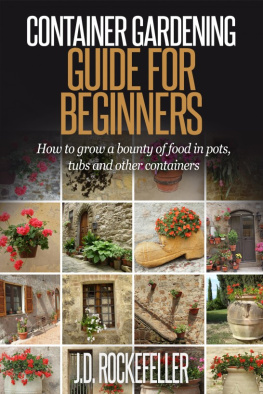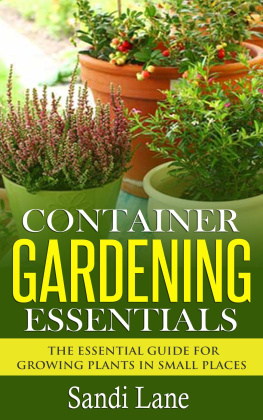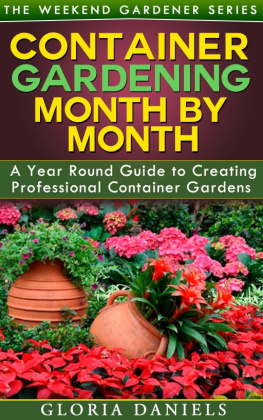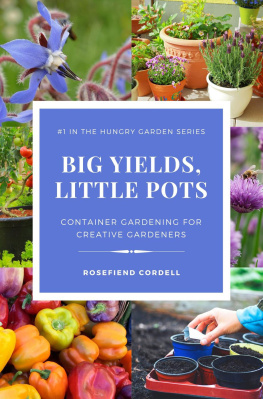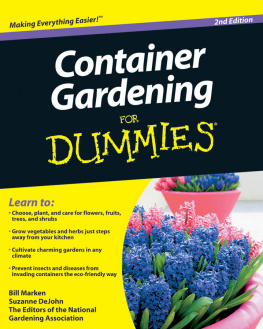Pots, Techniques, and Projects to Transform Any Space
CONTAINER
GARDENER'S
HANDBOOK
FRANCES TOPHILL
Photography by Rachel Warne


Container Gardeners Handbook
CompanionHouse Books is an imprint of Fox
Chapel Publishers International Ltd.
CompanionHouse Books Project Team
Vice President-Content: Christopher Reggio
Editor: Amy Deputato
Art Director: Mary Ann Kahn
First published in Great Britain in 2017 by
Kyle Books, an imprint of Kyle Cathie Limited
192198 Vauxhall Bridge Road
London SW1V 1DX
www.kylebooks.co.uk
Text Frances Tophill 2017
Photographs Rachel Warne 2017
Design Kyle Books 2017
Editor: Vicky Orchard
Design: Helen Bratby
Photography: Rachel Warne
Production: Lisa Pinnell
All rights reserved. No part of this book may be reproduced, stored in a retrieval system, or transmitted in any form or by any means, electronic, mechanical, photocopying, recording, or otherwise, without the prior written permission of Fox Chapel Publishers, except for the inclusion of brief quotations in an acknowledged review.
ISBN 978-1-62008-330-7
Library of Congress Cataloging-in-Publication Data
Names: Tophill, Frances, author.
Title: Container gardeners handbook : pots, techniques, and projects to
transform any space / Frances Tophill.
Description: Mount Joy, PA : Fox Chapel Publishing, [2019] | Includes index.
Identifiers: LCCN 2018043589 (print) | LCCN 2018047019 (ebook) | ISBN
9781620083314 (ebook) | ISBN 9781620083307 (softcover)
Subjects: LCSH: Container gardening.
Classification: LCC SB418 (ebook) | LCC SB418 .T67 2019 (print) | DDC
635.9/86--dc23
LC record available at https://lccn.loc.gov/2018043589
This book has been published with the intent to provide accurate and authoritative information in regard to the subject matter within. While every precaution has been taken in the preparation of this book, the author and publisher expressly disclaim any responsibility for any errors, omissions, or adverse effects arising from the use or application of the information contained herein.

Fox Chapel Publishing
903 Square Street
Mount Joy, PA 17552
Fox Chapel Publishers International Ltd.
7 Danefield Road, Selsey (Chichester)
West Sussex PO20 9DA, U.K.
www.facebook.com/companionhousebooks
We are always looking for talented
authors. To submit an idea,
please send a brief inquiry to
Printed and bound in China
22 21 20 192 4 6 8 10 9 7 5 3 1

WHY SHOULD WE GARDEN WITH CONTAINERS?

I can think of four great reasons:
The first is that containers are so convenient. No matter how much or, crucially, how little space you have, containers help us to bring greenery, scents, colors, and edibles into our lives.
Containers also offer you flexibility in your garden design because you can move pots around or change their contents. This is a great asset; growing conditions that would otherwise be inherently unchanging can be exploited to their full potential. If a plant isnt happy where it is, you can move itwith no disruptionfrom shade to sunshine or from a windy spot to a sheltered nook. The ability to move a plant is really useful and means you can grow many plants that otherwise might not thrive in your plot.
Another obvious benefit is that pots contain the roots of a plant, which is useful for a number of reasons. It might be necessary to prevent a plant from spreading, such as with a bonsai tree or a very vigorous bamboo, or a plant may need special conditions, such as a very specific soil type that is not present in your garden, extra drainage, or a particularly acidic environment (see ). It also helps to hold roots in a space that is usually inhospitable, giving them the opportunity to feed and hold on against the oddssuch as on a wall or windowsill.
Believe it or not, pots have fantastic design potential. With so many different shapes, sizes, and colors of containers and a whole kingdom of plants to play with, they can add a brilliant and varying aesthetic to your garden. Close your eyes and imagine a planted pot. I bet I can guess the first thing that popped into your head: the pot was terra-cotta and had something flowery in it. A geranium, lets say. Or maybe it was a hanging basket? Perhaps something with petunias trailing over the sides? The point I am trying to make is that, for some, growing in containers has become something of a clichd concept. We tend to think of fail-safe, tried-and-true arrangements. However, there is so much choice and with the further options of upcyclingand even of making your own potsthere really is no excuse for thinking that theres only one way of growing in containers. Think outside the box (or should I say pot?) and try something different. Plants are good for the soul; they purify the air around us and fill our spaces with pockets of green (one of the most soothing colors) as well as providing havens for wildlife. Plants are also useful: we eat them, we put them in vases, we make dye with them, and we use them as the basis for all kinds of medicine. So whatever your space, there really is no excuse for not making a little room for a plant or two. Even just a couple of plants will give you joy and a sense of tranquility as you nurture them and watch them grow. What better activity is there to do with your children or friends or for some peaceful creative time than fashioning a container that will be exactly what you want, filled with plants you love?

Succulents from the genus Crassula or Haworthia bring beauty to a small corner of a greenhouse.
There is a knack to achieving the perfect container. Ive seen some done badly or packed with insufficient or dull bedding. People tend to revert to the fail-safe option of alternating bulbs in the spring with bedding plants in the summer and then maybe some pansies in the winter, if they can be bothered. These types of displays, the kind commonly planted by clubs or in public parks, are uninspiring, to say the least. But containers need not be synonymous with these kinds of safe and predictable displays. These poor pots, brimming with potential, didnt ask to be filled with the same old species, without color or form even being a consideration. All that compost, all those nutrients, could have gone to feed and nurture something truly exquisite. There is a whole world of potential to be unlocked from containers that are just sitting in the shed or around the side of the house collecting dust, weeds, moss, and possibly spiders. I implore you to resurrect, revamp, and replant these containers and, this time around, give them a chance to shine. Think of them as the key element of your design, not just a finishing touch or an afterthought. Unleash their true potential.

Next page

